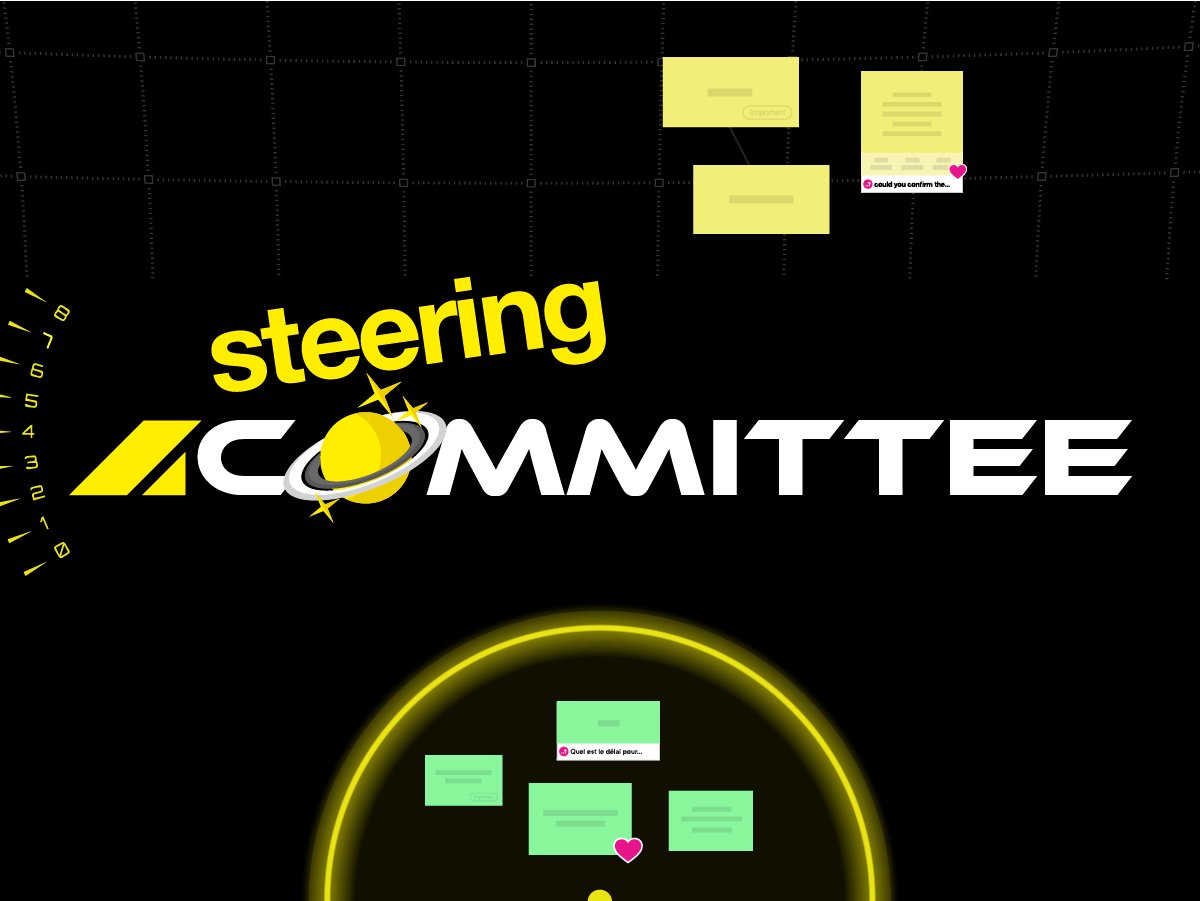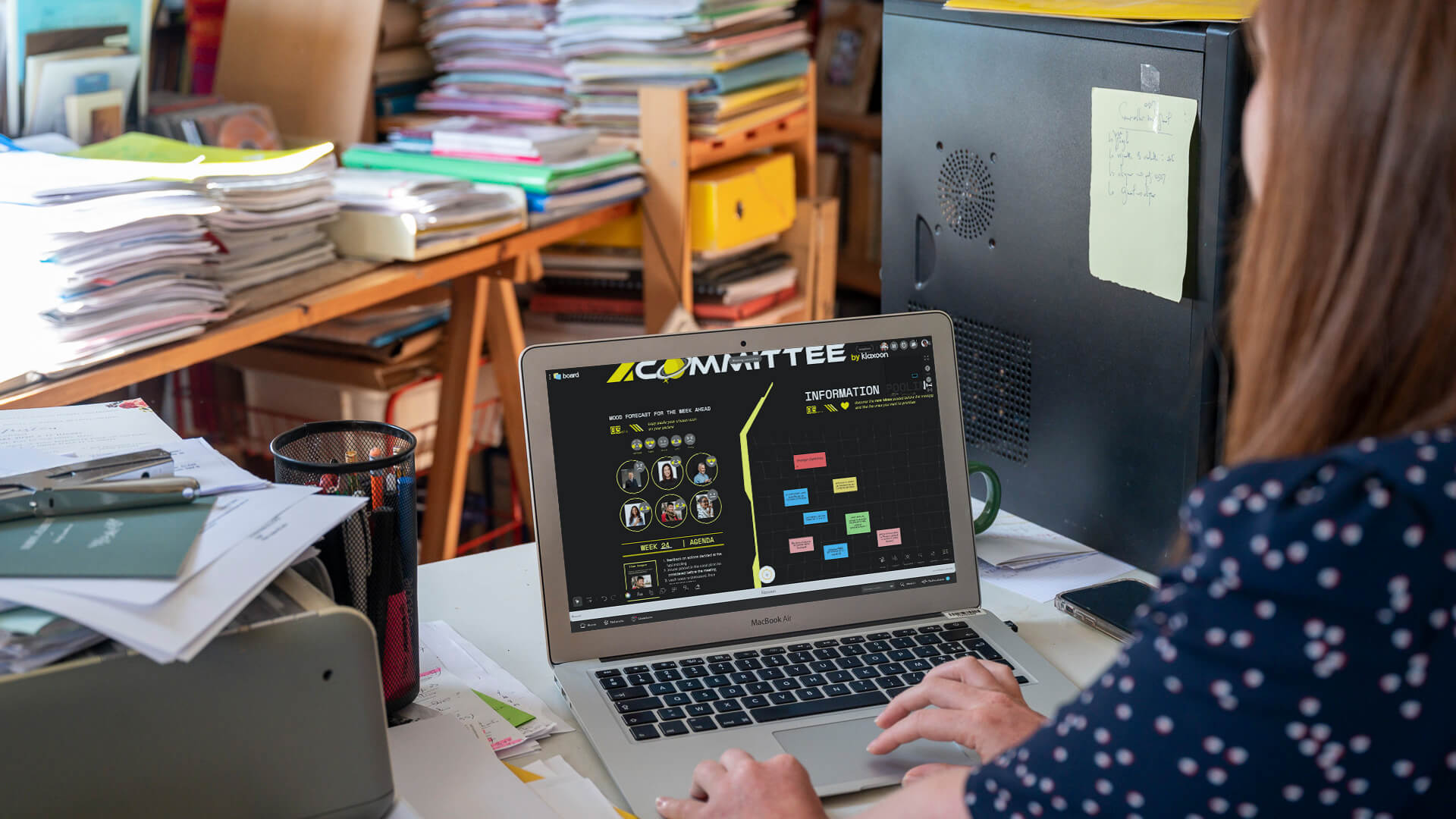Steering Committee: make the right decisions to achieve project objectives
Published on February 14, 2025
Steering Committee: make the right decisions to achieve project objectives


An efficient collective decision-making tool to breathe new life into your high-worth projects
How does one guarantee the success of long-term projects when your team cannot physically work together every day? With remotely managed projects, what do you do to preserve closeness between role players? How do they all stay in the know of everyone else’s progress and of the project as a whole? Is it possible to guarantee good communication between the main partners? And how do you make sure that the best instructions and orders will be communicated to each participant in each team working on your project?
To answer these questions, Klaxoon designed a ready-to-use model that combines great tools with outstanding methods. The Copil template is easy to set up, gives you a centralized view of each participant’s progress, and offers you tried and tested teamwork and project management solutions, whether inhouse or remotely. For example, the start-up weather option kicks off get-togethers in a more user-friendly and meaningful fashion, while the design thinking space helps you produce creative ideas. The voting tool then facilitates strategic decisions. And all along the dashboard format helps you keep hot ideas warm as you first focus on overall project progress.
Whether you’re a project manager or participant, most likely you’re used to regularly meeting your colleagues in person during get-togethers where you present your progress, problems, requests and keep one another informed. Copil (a French acronym for Steering Committee) is something totally different. It brings together the key members of your project team, usually one member per profession needed for the project, as well as your sponsors, along with the project manager(s). Copil members are not necessarily managers, but members of a transversal group of stakeholders. The steering committee meets to take strategic decisions and set guidelines for the project.
Each steering committee meeting is dedicated to project oversight. It is not a meeting designed to last a long time, but to build networks between participants, ensure good communication on all aspects of a project, and together to take decisions on the next steps. It shouldn’t exceed one or two hours max (in case of blockages or important strategic decisions). Copil meetings could take place once every two weeks, once a month or still less frequently. The frequency may vary depending on the overall duration of the project and number of people involved. A calendar specifying the dates and length of each Copil meeting should be set in advance to avoid double bookings and allow busy participants to attend.
Whether at the office or remotely, the interested parties get together to post their ideas to a board, discuss them, and take decisions shaping the outcomes (e.g. adjusting targets, allocating or redeploying human, technical and financial resources, solve problems, and so forth).
So, how does a Copil steering committee come to agreement? Easy! Before the meeting starts, everyone posts his or her ideas, questions, information and suggested decisions on an online whiteboard. Then, during the meeting, the participants organize and manage proceedings, discuss the issues at hand, and finally vote on them. They thus take their decisions based on what was shared, and arrive at an action plan. This is where the flexibility and user-friendliness of Klaxoon’s Copil template time and again proves its worth!
Taking collective decisions: If the project you’re working involves high stakes, complex specs, a large number of participants or tasks that overlap with different units or departments of your company, it becomes essential to set up a steering committee. The project manager responsible for transversal management of all tasks involved by the project cannot alone take decisions for all of investment, suppliers, resources and quality. He or she must therefore regularly bring together all of the main parties in order to collectively take the best decisions.
Steering committees meetings present another very important advantage by helping ensure project buy-in, even of those not involved in the project daily or working on lower levels. Today, with the Covid-19 pandemic and advances in technology, lots of hybrid forms of work are appearing. Teams find themselves dispersed. But they still need to work together closely. New videoconferencing tools, telephone and hybrid meetings and visual management solutions make all of this possible. Whether you’re able to meet in person, or work mainly remotely, it is essential that you keep meeting regularly and stay in the know of overall developments in the project, because it helps you maintain tight working relations with colleagues and remaining efficient in team settings. On a personal level, each participant or representative of a specific project part needs these regular get-togethers to remain confident of the project, motivated and keen to reach its objectives. And on a professional level, steering committee meetings keep workers on the same wavelength, provide an opportunity to share information and help all advance toward the same objectives. All of which help ensure project success.
All participants share an online whiteboard that allows them to manage the different aspects of a meeting (e.g. information sharing, discussions and strategic decision-making). Before the start of the meeting, each simply fills out his or her information in a dedicated section of the board. Then, during the Copil meeting, discussion moves from one key subject to another, followed by a collective decision on each. Thus, by smoothing out the decision-making process, Klaxoon’s Copil template really turns into the dashboard of the project.
Before the meeting starts, the project manager will create and personalize his Copil template. Next he invites his colleagues to join in. Each participant can add a picture and his/her name to personalize him/her in the meeting.
Prior to the meeting, all steering committee members can submit ideas, suggestions and questions on the online whiteboard. The color codes allow quick identification in terms of importance, urgency, the need for a decision or action to be taken, or indicate whether it primarily involves information.
All colleagues participating in the Copil meeting must consult the board prior to the meeting to know and understand all the latest developments and managerial aspects of the project. This will considerably cut meeting times, and participants should take some time to prepare.
Invite each participant to describe his/her mood by posting the corresponding weather icon along with a picture. The ‘weather situation’ must be brief and representative. It allows participants to know in what state of mind and mood the others are, which is important for adjusting to what other feel like, better understand them or gauge their behavior. Because good project management also depends on an appreciation of human factors.
Next, one participant may offer to be the ‘time master’ by placing his picture on the designated spot in the template, or be appointed by the other members of the group. The idea is to have a different time master at each Copil meeting. This helps all to participate and make for more dynamic meetings. The time master is responsible for minuting the discussions and decision-making. He/she must ensure that the meeting remains short, sweet, does not bore participants and ends in decisions taken when all are still fresh and sharp!
The best is to give participants five minutes to take note of all the ideas, suggestions, problems and other issues posted on the board. The continue by ‘liking’ those that you view as priority. This allows you to rate the subjects into levels of importance and build an agenda.
The meeting agenda is thus built collectively in the space of minutes, and displayed on the online whiteboard. This first part of the template also allows you to post ideas and decisions validated or taken at the last Copil meeting. This all helps you keep the big picture front and foremost, take note of recent developments and remain mindful of what was discussed at previous meetings.
Once the agenda has been set, you can launch the meeting!
OK, the meeting has started! What now? Well, if some or all of the participants dial in from outside locations, launch Live, i.e. the Klaxoon Board’s integrated videoconferencing solution. Once the information sharing stage completed, discussing of each subject can proceed. We recommend you don’t spend more than 15 minutes on any given topic to avoid spending too much time on any subject and not get on with other important ones.
The Copil template offers participants a chance to share their views. Use the planet symbol to take your turn. In this way, the group stays attentive and each gets an opportunity to weigh in on issues. If needed, you may, in the same way as for the ‘time master’, designate a ‘turn master’ who will allocate the planet to participants in line with the questions asked or input required. Whether all present in one room or participating remotely, you use signs (e.g. a raised hand) to indicate to the ‘master’ that you’d like to speak next.
Thus, whether through collective meeting agenda setting or self-managed discussions, the Copil template allows you to get together as a real team, work together in real time, and together bring the project to success!
In the course of the discussion, or during transition stages, suggestions and requests may surface. The Questions tool allows you to vote on such input with the stars sign (up to 5 stars). To validate a suggestion, you need to get at least 3 out of 5 stars. If not, you may opt to reopen the discussion. Allow 10 minutes’ meeting time to define the next strategic stages in a project, and in the reserve box rate the ideas not reviewed yet (or matters pending). Then decide together what actions need to be taken to reach your project’s objectives.
No ideas can disappear from the board. The template will keep them on the ‘back burner’ for the next Copil meeting. This simplifies the decision-making process while ensuring greater clarity and efficiency of overall project management.
To end a meeting, take 10 minutes to keep or adjust your strategic targets in the Copil template sights. Each idea may be allocated an implementation time before it is distributed to a specific person (name and picture). This way all participants keep a clear and detailed picture of the current state of projects as well as the future actions to be taken.
With Copil meetings, project management and teamwork – whether inhouse or remote – is made real easy!


Get inspired by other templates from the same categories
Unlock your teamwork potential